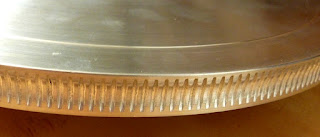*
 Two months after ordering the wormwheels they have arrived. The first set were made with a 1.25" bore so I had to wait another month while another set was made. I ordered nominal 11" and 8" diameter wormwheels with a 50mm bore and matching worms and received 11.5" and 8.75" wormwheels [293mm & 222mm] with 60mm bores. Tooth count is 287 in both cases. This matches a 5rpm synchronous motor drive. Though stepper motors are possible and actually more popular these days.
Two months after ordering the wormwheels they have arrived. The first set were made with a 1.25" bore so I had to wait another month while another set was made. I ordered nominal 11" and 8" diameter wormwheels with a 50mm bore and matching worms and received 11.5" and 8.75" wormwheels [293mm & 222mm] with 60mm bores. Tooth count is 287 in both cases. This matches a 5rpm synchronous motor drive. Though stepper motors are possible and actually more popular these days. I was told that the machinest is a gentleman in his mid 80s and now reaching the end of his desire to continue after two decades of producing these wormwheel sets in up to 14" diameter. The 14" are now discontinued. My own wormwheels are numbered 567 and 568 which is rather a lot of anything made to this level of precision.
The worms used to be made in stainless steel but these are now of brass. If I outlive them [as I approach 70 years of age] that will be a remarkable bonus!
 They arrived in a very large box with masses of protection even including pipe insulation wrapping the circumference of the wheels.
They arrived in a very large box with masses of protection even including pipe insulation wrapping the circumference of the wheels. I had no real idea of the true dimensions until they arrived so have postponed any serious progress on the mounting. I shall now have to make brass sleeves to match the 60mm bores to my 50mm stainless steel shafts. Making smaller holes larger is impossible if accuracy is to be maintained. Sleeving to make the central holes smaller is possible with care.
 Note how the "threads" on the worms are coarser for the larger wheel. This makes obvious sense because the number of teeth on the wheel does not change while the circumference grows considerably.
Note how the "threads" on the worms are coarser for the larger wheel. This makes obvious sense because the number of teeth on the wheel does not change while the circumference grows considerably. The worm housings are simple U-channel profiles in sturdy cross sections to avoid flexure. The worms are held in journal bearings pressed into the webs of the channel section and fixed securely with tiny, SS grub screws.
The worm housings are simple U-channel profiles in sturdy cross sections to avoid flexure. The worms are held in journal bearings pressed into the webs of the channel section and fixed securely with tiny, SS grub screws.A view of the 'teeth' on the larger wormwheel. The thread on the worm engages over much its flanks to avoid play and ensures low wear in the wormwheel teeth.
 Each wheel bush has three radial holes to take stainless steel grub screws with nylon pressure plugs. The latter press against the mounting axis shafts to provide a very simple clutch to allow the telescope to be moved easily, independent of, and without disengaging the worms.
Each wheel bush has three radial holes to take stainless steel grub screws with nylon pressure plugs. The latter press against the mounting axis shafts to provide a very simple clutch to allow the telescope to be moved easily, independent of, and without disengaging the worms.The overall finish is very acceptable but the teeth could do with a scrub with a fine wire brush to remove some slight debris from the machining process. The vendor recommended lapping with plain oil rather than using any abrasive or even metal polish. His argument was that polishing particles would tend to bed into the materials and continue to cause wear over time.
Click on any image for an enlargement.
*

No comments:
Post a Comment